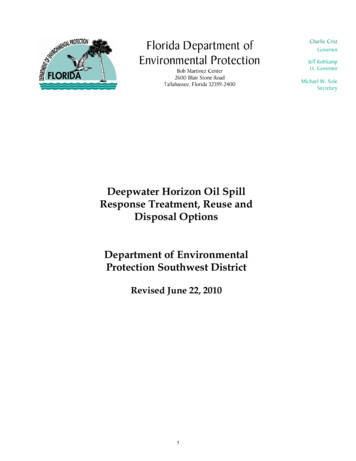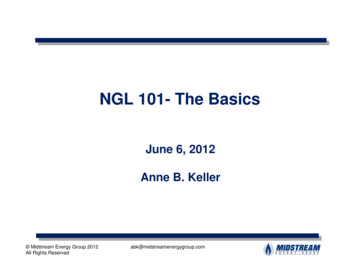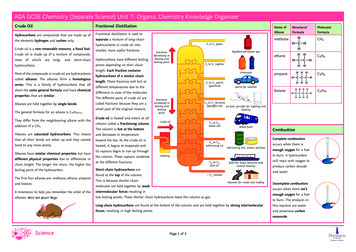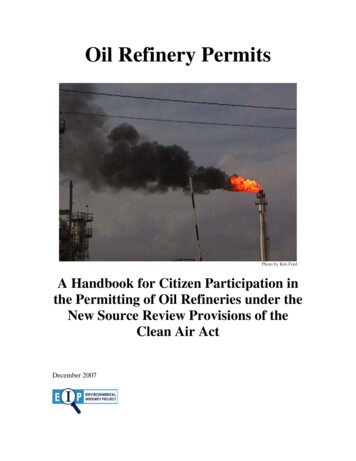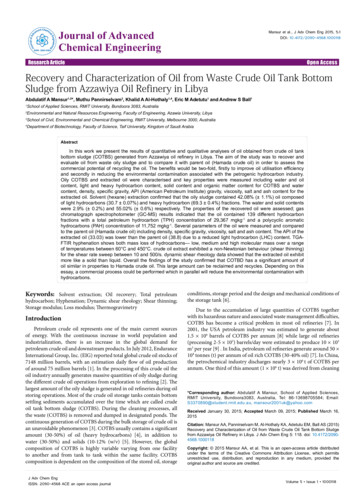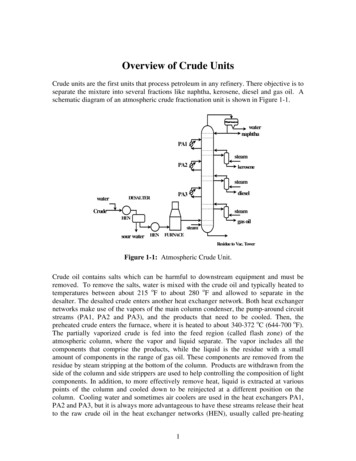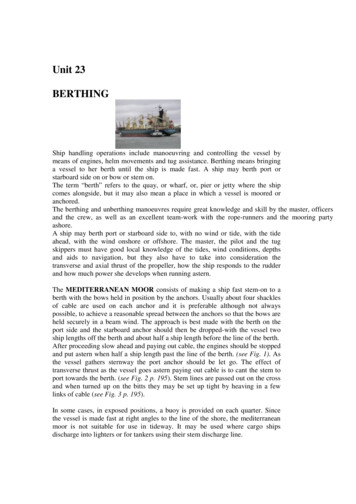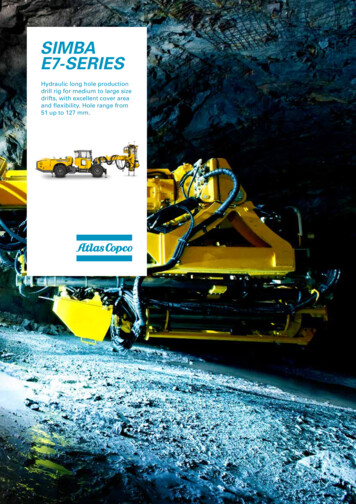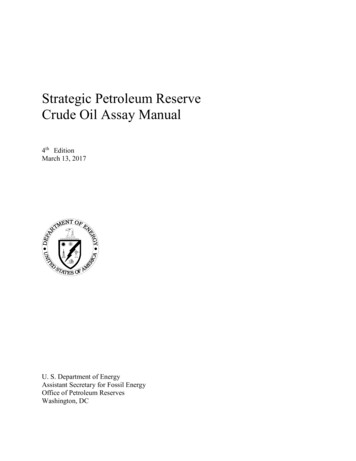
Transcription
Strategic Petroleum ReserveCrude Oil Assay Manual4th EditionMarch 13, 2017U. S. Department of EnergyAssistant Secretary for Fossil EnergyOffice of Petroleum ReservesWashington, DC
Table of ContentsPreface . iiiI.Acquisition and Storage of Crude Oils . 1II.Crude Oil Quality Assessment Program . 3III.Laboratory Procedures . 4IV.Crude Oil Composition of SPR Streams . 5Appendix A. Approximate Crude Oil Composition of SPR Streams . 18Appendix B. Procedures for Collection of Samples for H2S Determination . 22Appendix C. SPR Crude Oil Assays . 24Bayou Choctaw Sour . 5Bayou Choctaw Sweet . 27Big Hill Sour . 9Big Hill Sweet . 31Bryan Mound Sour . 33Bryan Mound Sweet . 5West Hackberry Sour . 37West Hackberry Sweet . 39TABLESTable I. SPR Crude Oil Specifications . 8Table II. Typical SPR Cavern Sample Oil Inspection Analysis . 10Table III. SPR Crude Oil Comprehensive Assay Grid . 11i
Page intentionally left blankii
PREFACEThis booklet provides detailed information on the specifications for crude oils to beacquired for storage in the Strategic Petroleum Reserve (SPR), procedures used to assess qualityof the stored petroleum during protracted storage, and methods used in developing assays of thevarious streams that may be sold. Assays of the eight SPR streams are provided. This editionsupersedes the third edition, March 2008, as revised February 2017.Any questions regarding sampling practices, analysis procedures, or the assays themselvesshould be addressed to Director, Operations and Readiness (FE-43), Office of Petroleum Reserves,Washington, DC 20585-0340, telephone 1 (202) 586-8197. This office should also be contactedfor the latest edition of the SPR Crude Oil Specifications shown in Table I and a list of currentlyacceptable crude oils.iii
iv
I.Acquisition and Storage of Crude Oils.Recent technological advancements in drilling and completion techniques for the production ofcrude oil from shale formations, such as Hydraulic Fracturing1 (also hydrofracturing,hydrofracking, fracking, or fraccing) has increased the availability of light crude oil from thevarious domestic shale plays. The majority of the shale oil production currently is from theBakken, Marcellus, Utica and Eagle Ford producing areas. The Wolfcamp area in the MidlandBasin is expected to contribute an additional 20 billion barrels of shale-derived crude oil over itslifetime. These shale crude oils display higher API gravities than crudes typical for the SPRalthough most fall within the SPR Crude Oil Specifications listed in Table 1. These shale oilsroutinely show high bubble point pressures (BPP) and high gas‐oil ratios (GOR) which presentlogistics and environmental concerns for the SPR.The majority of this new shale production is in areas with very little oil processing capabilities ortransportation infrastructure. As crude oil processing and transportation infrastructures aredeveloped in each production area the SPR expects issues associated with high vapor pressuresin crude oil will be mitigated over time. Increased vigilance by marketing, transportation, andenvironmental organizations will compel producers to resolve the challenges associated with thesale and shipment of these light crude oils.The specifications for the acquisition of crude oil for storage in the Strategic Petroleum Reserve(SPR) were originally developed in 1976. At that time, six categories of crude oil were defined.These encompassed a large segment of crude oils– both domestic and foreign – being processedby U. S. refineries at that time and included projections of future runs based on new fields beingdeveloped such as those on the Alaskan North Slope and in the North Sea.These categories included one medium-gravity, sour2 crude oil of nominal Arabian Light quality;four medium-gravity, sweet2 categories, covering North and West African streams and productioncoming on-stream in the North Sea; and a heavy, sour category specific to Alaskan North Slopeproduction. Later, a seventh category was added to allow for acquisition of Mexican Maya crudeoil.For practical reasons related to drawdown logistics, it was not possible to segregate all thesevarious categories in storage and essentially four segregations evolved. The two largest of thesein terms of volume were a medium gravity, sour of nominal Mexican Isthmus quality, and amedium gravity, sweet of nominal Ninian/Forties quality. Another segregation comprised AlaskanNorth Slope crude commingled with medium gravity, sour crude oils, and the fourth segregationwas Mexican Maya. Due to technical considerations unrelated to crude oil quality or drawdownlogistics, the Alaskan North Slope segregation formerly stored in the Weeks Island Mine has beenrelocated and commingled with medium gravity, sour crude oils. The Maya segregation has nowbeen disposed of and replaced by other crude oils. Today, only two specifications – one sweet andone sour, both of medium gravity – are used for acquiring crude oil for the SPR (Table I).Member companies of the American Petroleum Institute (API), the American Fuel andPetrochemical Manufacturers Association (AFPMA), along with other industry groups andpetroleum companies have reviewed these specifications as they have evolved over the past four1
decades. Minor changes to the SPR’s acceptance criteria have been made as the result of theseinformed suggestions. The SPR strives to acquire domestic and foreign crude types with the widestrange of application in domestic refining.Currently the SPR has a sweet and a sour segregation at each of its four sites. The approximatecrude oil makeup of each of these eight segregations is summarized in Appendix A. Experiencedemonstrates that the crude oils known to conform to each category are compatible and thatchemically-based degradation does not occur during long-term storage. Mexican Isthmus is thedominant crude oil comprising all four sour segregations, and U. K. Brent, Forties, and Ninian3are the dominant crude oils comprising three of the four sweet segregations. Girassol is thedominant crude oil comprising the Bayou Choctaw Sweet segregation.To maintain overall homogeneity for an assigned crude classification only crude oils of similarcomposition are commingled in storage. For example, North Sea crude oils such as U. K. Brentand U. K. Forties may be commingled, as would Arabian Light and Dubai. Arabian Light wouldnot, however, be commingled with Brent or Forties, or other “sweet” crude oils. There are,however, several exceptions to this general rule. At both Bayou Choctaw and Big Hill, AlaskanNorth Slope has been commingled with medium gravity, sour crude oils following its transferfrom the now abandoned Weeks Island Mine storage facility. And also at Bayou Choctaw andBig Hill, relatively small amounts of Maya are commingled in the sour crude oil segregations.Despite these exceptions, the composition of the crude oil mixture in the preponderance of SPRcaverns conforms to one of the two specifications in Table I.Consideration has also been given to the increased use of Bakken and other tight oils in the Gulfcoast oil market. These high BPP-GOR oils have had a significant impact on the existing SPR oilinventory with respect to light ends composition. As a result, the SPR Crude Oil Specificationswere revised to address this issue. Updates to the testing options have been added in Table 1.II.Crude Oil Quality Assessment Program.Shortly after a storage cavern has received a delivery of crude oil a multi-level series of samplesis collected for laboratory analysis. Caverns are normally resampled at approximately eight totwelve year intervals. Some cavern maintenance activities provide opportunities for collectingrepresentative samples at shorter intervals than described above. As an example a pressurized lineflowing sample from a cavern determined to be well mixed at the end of degasification is anexcellent candidate for a comprehensive assay. An inspection analysis (Table II) of each cavernsample is performed to ascertain if there is any stratification or differentiation of the crude oilmixture. If none is evident, a composite sample is made of the individual oil samples and acomprehensive crude assay is performed. The specific test schedule for this analysis is listed inTable III.Extensive studies of crude oil stockpiles held in cavern storage have shown convective mixing,induced by the natural geothermal gradient in the cavern, results in commingled crude oils2
becoming well mixed when stored in large underground caverns such as those of the SPR5. Whileno deleterious changes in quality are known to occur to crude oil stored in solution-mined cavernsin salt, a relatively small volume of dense, viscous, and waxy material containing emulsified watermay accumulate in some caverns. This “sludge or rag layer” appears to be a natural phenomenonand not the result of incompatibility between various crude oils commingled in storage6. Thislayer is not removed from a cavern during a drawdown and does not become a component of thestream that is sold.3
III.Laboratory Procedures.All crude oil samples are analyzed using ASTM-International standard test methods7 except wherespecifically noted in Table III. Analyses of the distillation fractions also are performed usingASTM-International Standard Test Methods except where indicated in Table III. All test resultsare reported in accordance with the respective test method’s instructions, except as otherwiseindicated. Many of the listed procedures have been adopted by other international standardsorganizations and given numerical designations unique to that standards body. As an exampleASTM Test Designation D5853-11 is identical in all aspects to IP Test Designation 441/99 andwill be accepted as such when reviewing test data for accepting crude oil shipments into the SPR.ASTM analogues for many petroleum tests are published by IP, ISO, ANSI, and API.Atmospheric and Light Vacuum Distillation of the crude oil samples or composites isperformed in accordance with ASTM D2892 Standard Test Method for Distillation of CrudePetroleum (15-Theoretical Plate Column). Subsequent distillation of the residuum is performedusing ASTM D5236 Standard Test Method for Distillation of Heavy Hydrocarbon Mixtures(Vacuum Potstill Method). Distillation fractions are measured on a mass percent basis in bothprocedures, with volume percent values calculated using the specific gravity of each fraction.Acid Number. The threat of generalized acidic activity is measured using ASTM D664Standard Test Method for Acid Number of Petroleum Products by Potentiometric Titration.API Gravity. Either ASTM D1298 Standard Test Method for Density, Relative Density,or API Gravity of Crude Petroleum and Liquid Petroleum Products by Hydrometer Method orASTM D5002 Standard Test Method for Density and Relative Density of Crude Oils by DigitalDensity Analyzer are acceptable test methods for the determination of API gravity.Asphaltenes. ASTM D6560 Standard Test method for Determination of Asphaltenes(Heptane Insolubles) in Crude Petroleum and Petroleum Products is used for determining theircontent in the whole crude and in the atmospheric and vacuum residuum fractions. For wholecrude, the determination may be performed on both untopped and topped samples in accordancewith the instructions in Section 9.4 and Annex A1 of the test method.High Temperature Simulated Distillation (HTSD) data is obtained in accordance withASTM D7169 Standard Test Method for Boiling Point Distribution of Samples with Residues Suchas Crude Oils and Atmospheric and Vacuum Residues by High Temperature GasChromatography. Data obtained according to this method are permissible in conditionallyaccepting a crude oil for storage, but data obtained by ASTM D2892 and D5236 are still requiredfor final certification of a crude oil’s acceptability.Detailed Paraffin, Isoparaffin, Aromatic, Naphthene (PIAN) analysis of the naphthafractions to 191 C (375 F) for C1 through C12 hydrocarbons is performed using a modified versionof ASTM D5134 Standard Test Method for Detailed Analysis of Petroleum Naphthas Through nNonane by Capillary Gas Chromatography. This modified version provides for elution andidentification of components up to a nominal n-C12 (216 C). ASTM D6733 Standard Test Method4
for Determination of Individual Components in Spark Ignition Engine Fuels by 50-Metre CapillaryHigh Resolution Gas Chromatography is a functionally similar method requiring no modificationand may be used to identify naphtha components with a nominal end point of 225o C. ASTMD5443 Standard Test Method for Paraffin, Naphthene, and Aromatic Hydrocarbon Type Analysisin Petroleum Distillates Through 200 C by Multi-Dimensional Gas Chromatography may be usedfor lighter naphtha having an endpoint below 200o C.Hydrogen Sulfide. The hydrogen sulfide (H2S) values reported for the whole crude arefor naturally occurring, dissolved (existent) gas, while the values reported for distillationfractions represent evolved (potential) gas resulting from decomposition of thermally unstablesulfur compounds as well as H2S carried over during distillation. A modified version of UOP1639 Hydrogen Sulfide and Mercaptan Sulfur in Liquid Hydrocarbons by PotentiometricTitration is used for determination of hydrogen sulfide in the laboratory. Alternative methodsavailable for use are ASTM D7621-Standard Test Method for Determination of HydrogenSulfide in Fuel Oils by Rapid Liquid Phase Extraction- Appendix X1 and a modified version ofASTM D6021 Standard Test Method for Measurement of Total Hydrogen Sulfide in ResidualFuels by Multiple Headspace Extraction and Sulfur Specific Detection.Kinematic Viscosity. ASTM D445 Standard Test Method for Kinematic Viscosity ofTransparent and Opaque Liquids (and Calculation of Dynamic Viscosity) is used as the primarytest procedure for viscosity determinations at the temperatures listed. Samples that exhibit nonnewtonian flow may be analyzed using ASTM D7042 Standard Test Method for DynamicViscosity and Density of Liquids by Stabinger Viscometer (and the Calculation of KinematicViscosity).Light Ends in Crude Oil are tested in accordance with ASTM D7900 Standard TestMethod for Determination of Light Hydrocarbons in Stabilized Crude Oils by GasChromatography. Functionally this test method is essentially the same as the Intertek Light Endsmethod (ITM6008) and IP344. Significant challenges in maintaining a uniform level of stabilityfrom sampling to analysis led to the development of ASTM D8003 Standard Method forDetermination of Light Hydrocarbons and Cut Point Intervals in Live Crude Oils andCondensates by Gas Chromatography. More study is required before proposing this as thepreferred test protocol for qualifying and quantifying light ends content for SPR crude Oils.Organic Chlorides. To monitor for possible contamination by improperly disposedcleaning solvents or other forms of organically bound chlorine, all shipments of crude oil receivedfor storage in the SPR are routinely analyzed for organic chlorides. ASTM D4929 Test Methodfor Determination of Organic Chloride Content in Crude Oil is used for this determination.5
Pour Point. ASTM D97 Standard Test Method for Pour Point of Petroleum Products is theaccepted test method for this property. ASTM D5853 Standard Test Method for Pour Point ofCrude Oils (Procedure A) may be used as an acceptable alternate procedure.Salt Content. ASTM D6470 Standard Test Method for Salt in Crude Oils (PotentiometricMethod) and ASTM D3230 Standard Test Method for Salts in Crude Oil (Electrometric Method)are used extensively for measuring salt content in crude oil.Sulfur Content. Either ASTM D4294 Standard Test Method for Sulfur in Petroleum andPetroleum Products by Energy Dispersive X-ray Fluorescence Spectrometry or ASTM D2622Standard Test Method for Sulfur in Petroleum Products by Wavelength Dispersive X-rayFluorescence Spectrometry is acceptable for measuring sulfur content in crude oil.Vapor Pressure. While tedious, ASTM D323 Standard Test Method for Vapor Pressure ofPetroleum Products (Reid Method) remains a valid procedure for measuring the vapor pressure ofvolatile crudes as defined in the method’s scope. ASTM D6377 Standard Test Method forDetermination of Vapor Pressure of Crude Oil: VPCRx (Expansion Method) and ASTM D7975Standard Test Method for Determination of Vapor Pressure of Crude Oil: VPCRxF(Tm C)(Manual Expansion Field Method) have emerged in recent years as the preferred testprocedures for measuring the vapor pressure of crude oil. ASTM D5191 Standard Test Methodfor Vapor Pressure of Petroleum Products (Mini Method) generates test results with a consistentlylow bias when compared with data from the above listed procedures, therefore, aforementionedmethods are preferred.Water and Sediment Content. There is some flexibility in which sediment and waterprocedures may be used to generate a reported value combining the two properties expressed asvolume per cent. For water content either ASTM D4928 Standard Test Method for Water in CrudeOils by Coulometric Karl Fischer Titration or ASTM D4006 Standard Test Method for Water inCrude Oil by Distillation are the recommended methods. Results are to be reported as or convertedto volume per cent as required. Sediment content is measured either by ASTM D473 StandardTest Method for Sediment in Crude Oils or Fuel Oils by the Extraction Method or ASTM D4807Standard Test Method for Sediment in Crude Oil by Membrane Filtration. Sediment test resultsare converted to a volume per cent value. The volume per cent results for sediment and water arethen combined to generate a single value for Water and Sediment, Volume per cent.Wax. UOP 46 Paraffin Wax Content of Petroleum Oils and Asphalts is used fordetermining mass % wax content of the whole crude and the light and heavy vacuum gas oil (VGO)fractions.Quality Assurance. Laboratories providing crude oil analytical services for the SPRparticipate in the ASTM-International Interlaboratory Crosscheck Program for crude oil. Resultsfrom this program provide quantifiable evidence that the testing is performed to acceptable levelsof precision and accuracy. Additionally, all laboratories have an established internal quality6
assurance program to ensure conformance to best industry laboratory practices and in meetingdefined standards of quality at a stated level of performance.IV.Crude Oil Composition of SPR Streams.Each SPR crude oil stream is comprised of crude oil stored in multiple caverns. The storagevolume of individual caverns varies, with most being on the order of 10 million barrels (1.6 millionm3). Depending on the magnitude of a drawdown requirement of the SPR, one or more cavernscomprising the segregation may be used to make up a delivery stream. The analyses published inAppendix C are weighted averages of test results for the caverns comprising a given SPR stream.For five of the eight streams comparison of detailed assay data confirm there are only minorvariations in the analytical profiles for the individual caverns in a given stream. In the majority ofcases the cavern to cavern variation of a specific test result is within the testing precision for thedesignated test protocol used.For the other three streams, namely Bayou Choctaw Sour, Big Hill Sweet, and Big Hill Sour, thereare minor but noticeable differences in crude oil composition between the individual caverns usedto constitute the stream (Appendix A). While the analyses published for these three streams alsoare weighted averages, the analytical profile for a delivered stream may display minor deviationsfrom the published analysis, depending on which caverns are commingled during a drawdown. Tominimize the impact of these minor variations in fluid properties, a proportional drawdown ofcaverns comprising a given stream is practiced to the extent practicable.Analytical data for the crude oil composition of each storage cavern has been managed andarchived using the Haverly Systems, Inc. H/CAMS Crude Assay Management System or the SpiralSolutions Software, CrudeSuite Assay Management System. Both systems can reproduce assayreports based on actual test data from several decades ago. Each system also can generatepredictive assay reports for any combination of cavern test data using advanced modelingalgorithms. These are important capabilities in two respects. First, it allows a stream-specific assayto be developed for any combination of SPR caverns using any combination of analytical profiles.Second, changes in cavern quality resulting from deliveries between scheduled assay samplingscan be monitored, calculated, and addressed. The accuracy of the calculated results is enhancedwhen similar streams are used in the modeling process.The crude oil assays are also available in CRU file format, generated by H/CAMS or in CIF fileformat generated by CrudeSuite. Some properties listed in the assay result tables such as RONand MON are values calculated by the modeling software described earlier. Specific CRU-CIFfiles are available upon request by contacting the Director, Operations and Readiness, as directedin the Preface.7
TABLES I - III8
Table ISTRATEGIC PETROLEUM RESERVECRUDE OIL SPECIFICATIONS a(SPRO JULY 2015) ε1CHARACTERISTICPRIMARY ASTMTEST METHOD bSOURSWEETAPI Gravity [ API]30-4530-45D1298 or D5002Total Sulfur [Mass %], max.1.990.50D429410100.0500.050D6470[cSt @ 15.6 C], max.3232D445[cSt @ 37.8 C], max.Reid Vapor Pressure1313[kPa @ 37.8 C], max.7676Total Acid Number [mg KOH/g], max.1.001.00D664Water and Sediment [Vol. %], max.1.01.024-3017-3126-3810-1921-4219-4520-4214 max.473 and D4006,or D4928D2892 and D5236c0.010.11.00.010.11.0Pour Point [ C], max.Salt Content [Mass %], max.D97ViscosityYields [Vol. %]Naphtha [28-191 C]Distillate [191-327 C]Gas Oil [327-566 C]Residuum [ 566 C]Light Ends [Liquid Vol. %] d, maxMethane (C1)Ethane (C2)Propane (C3)ε1D323 or D5191IP344 or ITM6008This revision includes a limitation on light ends content (see Footnote d)aMarketable crude petroleum suitable for normal refinery processing and free of foreigncontaminants or chemicals including, but not limited to, pour point depressants, chlorinatedand oxygenated hydrocarbons, and lead.bAlternate methods may be used if approved by the contracting officer.cD 7169 data may be provided in requesting conditional acceptance of a crude oil.Distillation data according to D 2892 and D 5236 will still be necessary for finalqualification of a crude oil’s acceptance.dLight ends content specifications are interim and will be superseded if and when industrystandards for light ends evaluation are implemented.9
NOTE 1: The Strategic Petroleum Reserve reserves the right to refuse to accept any crude oilwhich meets these specifications but is deemed to be incompatible with existing stocks,or which has the potential for adversely affecting handling.NOTE 2: The acceptability of any crude oil depends upon any assay typical of currentproduction quality of the stream. Assays typical of current production quality aremandatory for any crude oil not received by the SPR within the last three years. Anycrude oil offered to the Strategic Petroleum Reserve that meets these specificationsmay be subject to additional testing for acceptance.NOTE 3: All crude oil shipments received by the SPR are tested to ensure they meetspecifications. Crude streams found consistently not meeting required specificationswill be removed from the list of acceptable crude oils.10
Table II. TYPICAL SPR CAVERN SAMPLE INSPECTION ANALYSISDate StartedSampleID5/8/2016RelativeDensitySampleLog 016NitrogenSulfurViscosity, t60/60 F API F(Mass %)(Mass %)at 77 Fat 100 F(Mass 91.2045--------Brine----Bottle LabelDate CollectedDateReportedExample Cavern11
12
APPENDICES A - C13
Appendix A. Approximate Crude Oil Composition of SPR Streams1,2Bayou Choctaw SweetCrude OilVolume %Girassol17HLSLLSNinian161512Es Sider8Brent & SLS6 eachCusiana and Forties4 eachKole, Oseberg, Qua Iboe, Sirtica, Bakken, &Zarzaitine2 eachBayou Choctaw SourCrude OilVolume %Isthmus35Iranian Light23Alaskan North Slope13Maya7Arabian Light, Dubai, Gulf of Suez Blend, & Mars4 eachMandji, Mesa 30, Oman, Thunderhorse, EIC, & UpperZakum2 eachBig Hill SweetCrude OilVolume %Brent28Girassol, NPR CA Stevens Zone, & ZafiroOseberg13 each9Es Sider, Kole, & Santa Barbara (Venezuela)FortiesAzeri Light, Saharan5 each3114
Big Hill SourCrude OilVolume %Isthmus26Alaskan North Slope & Urals16 eachArabian Light, Lagotreco, Mars, & Mesa 305 eachDubai, Iranian Light, & Oman3 eachGulf of Suez Blend, Lagomedio, Mandji, & Maya2 eachBryan Mound SweetCrude OilVolume %Forties34Ninian15Brent and Es SiderDomestic Sweet (DSW)12 each6Bonny Light, Forcados, & SirticaKole and Saharan4 each2 eachSanta Barbara (Venezuela), & Zafiro, Girassol, &Azeri Light1 eachBryan Mound SourCrude OilVolume %IshtmusUrals, Oman706 eachArabian Light, Dubai, & Olmeca5 eachHOOPS BlendForties3115
West Hackberry SweetCrude OilVolume %Brent and Forties20 eachNinianSaharan Blend, SLS, East Texas118 eachKole6Girassol5Bonny Light, Ekofisk, Es Sider, & EscravosHLS3 each 1West Hackberry SourCrude OilVolume %Isthmus59Mars18Arabian LightDubai95Iranian Light, & OmanURALS4 each11Quality of some crude oils changed significantly during the period they were received by the SPR. Among these areEkofisk, Forties, Girassol, and Isthmus.2Small quantities of crude oils other than those listed totaling less than 1 – 3% of overall volume may be present in agiven stream. These, and rounding errors, may result to columns not adding to 100%.16
Appendix B. Procedures for Collection of Samples for H2S DeterminationHigh Density Polyethylene (HDPE) bottles. Prepare the bottles by placing about 10 g ( 2 tablespoons) of dryice into each. Place the cap on the bottle and tighten loosely. Periodically loosen - but do not remove the cap- to relieve excess pressure. Continue this process until the dry ice has evaporated. Once the dry ice hasevaporated, tighten the cap and wait until the bottle is needed for sampling. Do not overpressure the bottles.If the bottles are not relieved of pressure buildup, they may explode.Bottles may be prepared up to twelve (12) hours in advance of when they will be needed. It is advisable toprepare at least one extra bottle in case one leaks.When ready to collect the sample, remove the bottle cap. There must be an audible hiss indicating the presenceof CO2 overpressure. If not, use another bottle. At the collection point, completely purge valves and lines ofstagnant oil. An amount approximately equal to three times the estimated volume of the line and valves backto the wellhead or pipeline should be purged and discarded. Slowly fill the bottle using a Teflon tubeextending to the bottom. When the bottle is full to the top of the shoulder, i. e., just below the threads, squeezethe bottle gently at the center just enough to cause a small amount (a few drops) of oil to spill over the lip ofthe bottle and while maintaining the bottle in this compressed state screw the cap on tightly (Note: Be carefulnot to spill oil, have sorbent material and/or whips readily available in the event of a spill). Wait several minutesto ensure that there is no headspace in the bottle as a result of sample degassing or leakage around the cap. Ifany headspace is present repeat steps c) and d) above. Wrap the cap/bottle area with electrical tape. Place thesample in
was Mexican Maya. Due to technical considerations unrelated to crude oil quality or drawdown logistics, the Alaskan North Slope segregation formerly stored in the Weeks Island Mine has been relocated and commingled with medium gravity, sour crude oils. The Maya segregation has now been disposed of and replaced by other crude oils.


